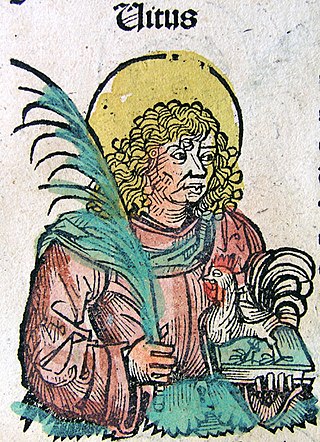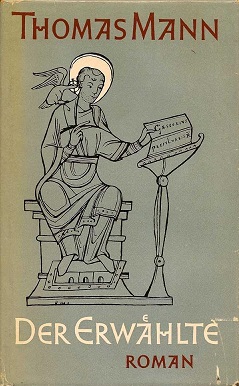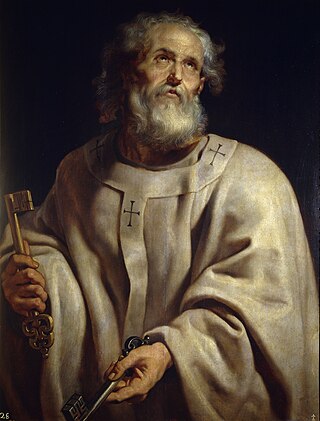Related Research Articles

Benedict of Nursia, often known as Saint Benedict, was an Italian Christian monk, writer, and theologian who is venerated in the Catholic Church, the Eastern Orthodox Church, the Oriental Orthodox Churches, the Anglican Communion, and Old Catholic Churches. He is a patron saint of Europe.

Vitus, whose name is sometimes rendered Guy or Guido, was a Christian martyr from Sicily. His surviving hagiography is pure legend. The dates of his actual life are unknown. He has for long been tied to the Sicilian martyrs Modestus and Crescentia but in the earliest sources it is clear that these were originally different traditions that later became combined. The figures of Modestus and Crescentia are probably fictitious.

Saint Valentine was a 3rd-century Roman saint, commemorated in Western Christianity on February 14 and in Eastern Orthodoxy on July 6. From the High Middle Ages, his Saints' Day has been associated with a tradition of courtly love. He is also a patron saint of Terni, epilepsy and beekeepers. Saint Valentine was a clergyman – either a priest or a bishop – in the Roman Empire who ministered to persecuted Christians. He was martyred and his body buried at a Christian cemetery on the Via Flaminia on February 14, which has been observed as the Feast of Saint Valentine since at least the eighth century.

Robert of Molesme was an abbot, one of the founders of the Cistercian Order and is honored as a Christian saint.
Saints Theodora and Didymus are Christian saints whose legend is based on a 4th-century acta and the word of Saint Ambrose. The pair were martyred in the reigns of co-ruling Roman Emperors Diocletian and Maximianus. St. Theodora should not be confused with another St. Theodora of Alexandria commemorated on September 11.
Cyriacus, sometimes Anglicized as Cyriac, according to Christian tradition, is a Christian martyr who was killed in the Diocletianic Persecution. He is one of twenty-seven saints, most of them martyrs, who bear this name, of whom only seven are honoured by a specific mention of their names in the Roman Martyrology.
A martyrology is a catalogue or list of martyrs and other saints and beati arranged in the calendar order of their anniversaries or feasts. Local martyrologies record exclusively the custom of a particular Church. Local lists were enriched by names borrowed from neighbouring churches. Consolidation occurred, by the combination of several local martyrologies, with or without borrowings from literary sources.

The Anaphora is the most solemn part of the Divine Liturgy, or the Holy Sacrifice of the Mass, a thanksgiving prayer by virtue of which the offerings of bread and wine are believed to be consecrated as the body and blood of Christ. This is the usual name for this part of the Liturgy in Greek-speaking Eastern Christianity. In the Eastern Syriac tradition Qudaša is its equivalent. The corresponding part in western Christian liturgy is nowadays most often called the Eucharistic Prayer. The Roman Rite from the 4th century until after Vatican II had a single such prayer, called the Canon of the Mass.

January 7 - Eastern Orthodox liturgical calendar - January 9

Alexandrian rites are a collection of ritual families and uses of Christian liturgy employed by three Oriental Orthodox churches, the Coptic Orthodox Church of Alexandria, Eritrean Orthodox Tewahedo Church, and Ethiopian Orthodox Tewahedo Church, as well as by their Eastern Catholic counterparts of the Coptic Catholic Church, Eritrean Catholic Church, and Ethiopian Catholic Church.

Placidus was a disciple of Benedict of Nursia. He was the son of the patrician Tertullus, was brought as a child to Benedict at Sublaqueum (Subiaco) and dedicated to God as provided for in chapter 69 of the Rule of St. Benedict (oblate).
The Roman Martyrology is the official martyrology of the Catholic Church. Its use is obligatory in matters regarding the Roman Rite liturgy, but dioceses, countries and religious institutes may add duly approved appendices to it. It provides an extensive but not exhaustive list of the saints recognized by the Church.

The Holy Sinner is a German novel written by Thomas Mann. Published in 1951, it is based on the medieval verse epic Gregorius written by the German Minnesinger Hartmann von Aue. The book explores a subject that fascinated Thomas Mann to the end of his life – the origins of evil and evil's connection with magic. Here Mann uses a medieval legend about "the exceeding mercy of God and the birth of the blessed Pope Gregory" as he used the biblical account of Joseph as the basis for Joseph and His Brothers, illuminating with his ironic sensibility the notion of original sin and transcendence of evil.

Saint Hermes, born in Greece, died in Rome as a martyr in 120, is venerated as a saint by the Catholic Church and the Eastern Orthodox Church. His name appears in the Martyrologium Hieronymianum as well as entries in the Depositio Martyrum (354). There was a large basilica over his tomb that was built around 600 by Pope Pelagius I and restored by Pope Adrian I. A catacomb in the Salarian Way bears his name.

Saint Abraham the Great of Kidunja was a 4th-century hermit and priest. He is venerated as a saint in Catholicism, Eastern Orthodoxy and Oriental Orthodoxy.

Saint Mellonius (229-314) was an early 4th-century Bishop of Rotomagus in the Roman province of Secunda Provincia Lugdunensis. He is known only from a 17th-century 'Life' of little historical value, meaning the historicity of his existence is uncertain.

Gregorius or The Good Sinner is a Middle High German narrative poem by Hartmann von Aue. Written around 1190 in rhyming couplets, it tells the story of a child born of the incestuous union of a brother and sister, who is brought up in a monastery, ignorant of his origins, marries his mother, repents of his sins and becomes pope.

October 21 - Eastern Orthodox liturgical calendar - October 23

December 25 – Eastern Orthodox liturgical calendar – December 27

Theodore was a sixth-century sacristan in the Church of St. Peter in Rome. He is mentioned in the writings of Gregory the Great, and was later venerated as a saint.
References
- ↑ Trzeciak, Frances (July 12, 2020). "Gregory the Great, in his Dialogues (3.26), describes three miracles effected by Menas, 6th c. hermit of Samnium". Cult of Saints in Late Antiquity. University of Oxford . Retrieved November 15, 2020.
- ↑ Martyrologium Romanum (in Latin) (2nd ed.). Vatican City: Libreria Editrice Vaticana. 2004. p. 616.
In província Sámnii, commemorátio sancti Mennæ, solitárii, cuius virtutes sanctus Gregórius papa Magnus commémorat.
- ↑ Martyrologium Romanum (in Latin) (revised post-typical 4th ed.). Justitias Books. 2017 [1956 with 1960 revisions]. p. 277.
In província Sámnii, beáti Mennæ solitárii, cuius virtútes et mirácula sanctus Gregórius Papa commémorat.
[In the province of Samnium, the blessed Mennas, hermit, whose virtues and miracles Pope St. Gregory commemorates.] - ↑ Saint Gregory the Great (c. 593). "3.26". Dialogues. The Fathers of the Church: A New Translation. Vol. 39. Translated by Zimmerman, Odo John. Catholic University of America Press (published 1959). pp. 159–160. ISBN 0813213223.